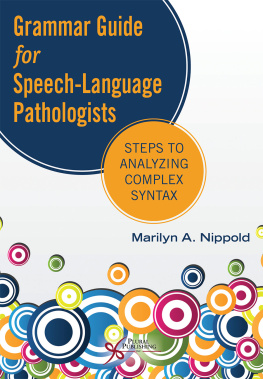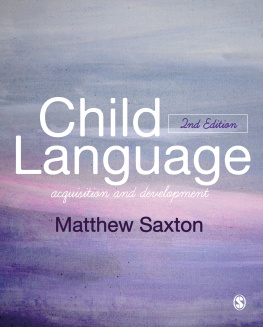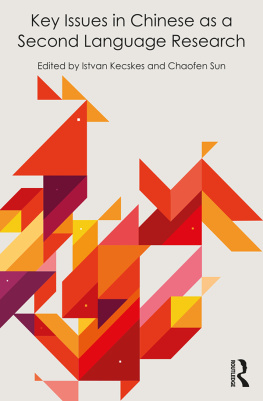Jean Berko Gleason - The Development of Language
Here you can read online Jean Berko Gleason - The Development of Language full text of the book (entire story) in english for free. Download pdf and epub, get meaning, cover and reviews about this ebook. year: 2022, publisher: Plural Publishing Inc., genre: Science. Description of the work, (preface) as well as reviews are available. Best literature library LitArk.com created for fans of good reading and offers a wide selection of genres:
Romance novel
Science fiction
Adventure
Detective
Science
History
Home and family
Prose
Art
Politics
Computer
Non-fiction
Religion
Business
Children
Humor
Choose a favorite category and find really read worthwhile books. Enjoy immersion in the world of imagination, feel the emotions of the characters or learn something new for yourself, make an fascinating discovery.
- Book:The Development of Language
- Author:
- Publisher:Plural Publishing Inc.
- Genre:
- Year:2022
- Rating:3 / 5
- Favourites:Add to favourites
- Your mark:
The Development of Language: summary, description and annotation
We offer to read an annotation, description, summary or preface (depends on what the author of the book "The Development of Language" wrote himself). If you haven't found the necessary information about the book — write in the comments, we will try to find it.
NOW PUBLISHED BY PLURAL!
This classic text now in its tenth edition and now available from Plural Publishing,The Development of Languagecontinues its focus on language acquisition in an unbiased, authoritative, and comprehensive way. Written by leading experts known for their research in the areas they discuss, this book has a multidisciplinary approach, and demonstrates the relevance of typical language development to speech-language pathologists, educators, clinicians, and those in other professions. Topics include the roots of language learning in infancy, phonology, syntax/grammar, word learning, bilingualism, pragmatics, literacy, atypical language development, and more.
This book provides the reader with an authoritative text that includes important and useful concepts and research findings. Emphasis is placed on language development in children who are learning languages other than, or in addition to, English, as well as children with risk factors for language delay or disorder. The text leads the reader through every stage of developmentthe early months before children begin to speak, the preschool and school years, and adolescence as children achieve mastery of adult-like language skills.
Key Features- Chapter pedagogy includes learning objectives, visual aids, video links, summaries, and suggested projects to extend students understanding and application of text concepts
- Key terms are highlighted in the text with definitions provided in a Glossary
- Clear and concise writing by authors who are known for their research in the subject area and their ability to explain complex topics to a broad audience
- A multilingual and multicultural focus on acquisition in languages other than English, on non-mainstream varieties of English and on children learning two or more languages simultaneously (bilingualism), as well as children with developmental communication disorders
- Restructure of chapters to streamline information
- Greater in-depth coverage of concepts that are frequently more difficult for students to master
- Updated references to new research and the current literature
- References are now at the end of each chapter
- New and updated figures and photos
- Coverage of the latest technological advances in basic research and clinical practice in child language
For Instructors: PowerPoint lecture slides, video links, and an Instructors Resource Manual, and a test bank.
For Students: Video links and eFlashcards
Jean Berko Gleason: author's other books
Who wrote The Development of Language? Find out the surname, the name of the author of the book and a list of all author's works by series.













 Each chapter has been updated and streamlined to more effectively highlight the most important concepts, theories, and findings that we believe are central to understanding the discipline and its applications to education, clinical practice, and real-life experiences.
Each chapter has been updated and streamlined to more effectively highlight the most important concepts, theories, and findings that we believe are central to understanding the discipline and its applications to education, clinical practice, and real-life experiences.